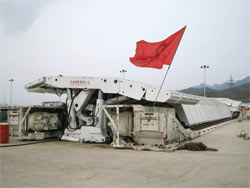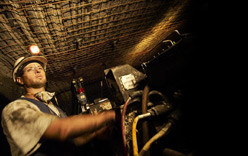LONGWALL TOP COAL CAVING

A partial or "mini" build on the surface of the
equipment for a Longwall Top Coal Caving face.
Photo courtesy of Joy Manufacturing Company Pty Ltd
A brief description of longwall top coal caving (LTCC) is included at the end of the Longwall section of the Fundamentals of Coal Mining module of this web site. Despite the fact that there are numerous coal seams in Australia which are thick enough for LTCC to be used to increase recoveries, potentially at a reduced cost/tonne, there has been little application of the process to date. It is possible that several sites with potentially suitable seams have examined the process closely and concluded it is not suitable for their conditions. However the process is widely used in China, apparently successfully, and it seems unlikely that all Australian seams are different from seams in China, which in turn implies that there is a possibility of a wastage of resources occurring as no attempt is being made to recover the full seam thickness of most very thick seams in Australia. Certainly there is a financial risk involved in purchasing new equipment, possibly replacing equipment which is still operating satisfactorily, in order to trial a process which may not be successful. The potential benefits may be large, but so is the risk of spoiling a successful operation already providing a satisfactory return on investment, and avoiding this risk is probably the correct financial decision in most cases. LTCC certainly involves many unknowns and untried equipment and it may be the case that maximising the use of resources will require financial support of some kind by government (possibly an effort of the type being applied to longwall automation described in the following part).
Actual and potential problems of LTCC include:
- Caving characteristics of the top section of the seam are not known with certainty. At other than a greenfield site, observation of the caving of current goaves can be monitored, although the current cutting height may be different from any proposed LTCC cutting height (the current height could be reduced for a period for test purposes). It is essential for good recovery that the top coal caves readily immediately behind the support canopies, fractures into small enough pieces to allow good flow through the rear canopy doors or openings and small enough not to cause problems along the rear AFC. The Chinese industry has developed a caving index based on observable or measurable properties which may be applicable to Australian conditions, in principle if not in actual values. Failure to cave satisfactorily would result in an expensive failure of the system;
- It is not only coal caving properties which have to be considered, but the caving properties of the overlying strata. If this strata does not cave with the coal there is the possibility of large voids forming with detrimental effects on support loading, ventilation, possible accumulations of gas close to the face and possible wind blast effects;
- Considerable design work is required for the face ends to include the drives for the rear AFC, particularly at the main gate face end where the BSL would have to extend through the main gate supports to the rear AFC and be protected from being buried by the goaf. In China the main gate is frequently supported by manually set hydraulic props rather than powered supports, but this system may not be acceptable in Australian mines;
- The overall length of the roof supports would be greater than normal supports to cover the rear AFC and allow space for access. The main canopy length may be little different but the rear section would have to be considerably longer. This may affect the design load capacity required as well as the ability to transport supports during recovery and relocation operations;
- Control of the floor strata beyond the support base may be difficult, leading to floor heave beneath the rear AFC which may be very difficult to correct;
- Face ventilation requirements will be more onerous, especially along the rear AFC and particularly if there is an appreciable gas make from the floor. Such floor gas is likely to issue from close behind the support base, below the rear AFC;
- Because the face will have two production locations (the shearer and the current cave draw point), there will be two potentially major dust production zones and, unless the two processes are separated (i.e. shear first, then stop shearing and draw the caved coal for the full length of the face), some personnel will be forced to work in dusty conditions at some location for considerable periods. Separating the two processes may still lead to good production, but will slow the rate of face advance and make it intermittent, factors which are generally detrimental to good longwall mining practice;
- In some cases, the additional surface subsidence resulting from an increased thickness of coal removed may be a problem;
- Poor face alignment may not only cause face roof control problems but also affect the caving process leading to lost production;
- If the possible high production rates are achieved with both mining processes in operation concurrently, the capacity of the outbye coal clearance system must be able to cope; and
- Even if the system is able to work perfectly, an extended learning period is likely to be required for personnel to gain sufficient experience to achieve the required results. Experienced trainers can possibly be sourced from China in the early stages but periods of training and gaining experience locally are likely to be at lower than optimum production.
So many risks, many with potentially serious consequences, present a major disincentive for any company to attempt LTCC without some form of financial assistance or guarantee. If successful the process could be extremely valuable in increasing recoverable resources and in reducing production costs. If not successful, it could result in a very expensive failure, and it is believed few companies are large enough to accept such a risk.
It is not known if the possibility of forced caving has been considered or attempted in cases where the top coal does not cave
successfully. Holes could be drilled between supports by retracting side shields (or providing suitable size holes in these shields for
drilling if retraction is considered unsafe). Shotfiring such holes probably involves too great a risk, especially in gassy seams. Pulsed
infusion firing with the charge close to the face may be less risky, but in any case there are types of high expansion materials available
which could be pumped into the holes and be successful in forcing the coal to cave as desired. The economics of such an operation would be a
major consideration.

